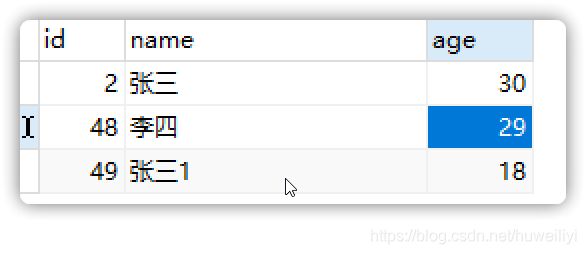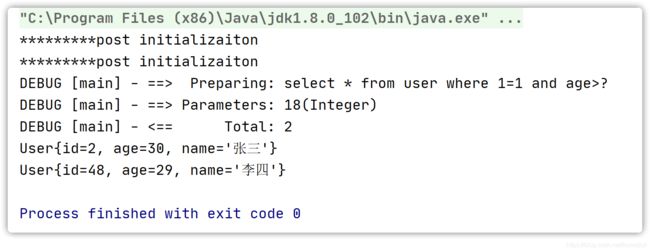【Mybatis】动态SQL最全解析
本文目录
- 引用
- if 标签
-
- 查询条件
- 接口方法
- 动态 SQL
- 测试代码
- choose(when、otherwise) 标签
-
- 动态 SQL
- 测试代码
- where标签
- set 标签
-
- 动态SQL
- 测试代码
- trim标签
- foreach 标签
-
- 接口方法
- 动态SQL
- 测试代码
- collection 值的指定
- bind 标签
引用
在使用 JDBC 的过程中, 根据条件进行 SQL 的拼接是很麻烦且很容易出错的。 MyBatis 动态 SQL 的出现, 解决了这个麻烦。Mybatis提供了动态SQL,可以根据用户提供的参数,动态决定查询语句依赖的查询条件或SQL语句的内容。
目前, MyBatis 动态 SQL 支持以下几种标签
| 元素 | 作用 | 备注 |
|---|---|---|
| if | 判断语句 | 单条件分支 |
| choose(when、otherwise) | 相当于 Java 中的 if else | 多条件分支 |
| trim(where、set) | 辅助元素 | 用于处理 SQL 拼接问题 |
| foreach | 循环语句 | 批量插入, 更新, 查询时经常用到 |
| bind | 创建一个变量, 并绑定到上下文中 | 用于兼容不同的数据库, 防止 SQL 注入等 |
在介绍各标签使用前,我们先创建一个Spring整合Mybatis工程 【Spring】Spring整合Mybatis案例
工程目录结构如下:

数据库中创建一张user表
DROP TABLE IF EXISTS `user`;
CREATE TABLE `user` (
`id` int(11) NOT NULL AUTO_INCREMENT,
`name` varchar(255) DEFAULT NULL,
`age` int(11) DEFAULT NULL,
PRIMARY KEY (`id`)
) ENGINE=InnoDB AUTO_INCREMENT=49 DEFAULT CHARSET=utf8;
if 标签
if 标签需要配合 test 属性联合使用,通常在查询、删除、更新的时候用到
查询条件
根据输入的用户信息进行条件检索
- 当只输入
name名时, 使用name进行模糊检索; - 当只输入
age时, 使用age条件进行匹配 - 当
name和age都存在时, 用这两个条件进行查询匹配查询
接口方法
@Repository("userMapper")
@Mapper
public interface UserMapper {
List<User> selectByUserSelective(User user);
}
动态 SQL
在UserMapper.xml中添加动态SQL
<mapper namespace="com.lucas.mybatis.mapper.UserMapper">
<select id="selectByUserSelective" resultType="com.lucas.mybatis.model.User"
parameterType="com.lucas.mybatis.model.User">
select * from user where 1=1
<if test="name != null and name !=''">
and name like concat('%', #{name}, '%')
if>
<if test="age != null and age > 0">
and age>#{age}
if>
select>
mapper>
测试代码
测试1:
public class App {
public static void main(String[] args) {
ApplicationContext applicationContext = new ClassPathXmlApplicationContext("applicationContext.xml");
UserMapper userMapper = (UserMapper) applicationContext.getBean("userMapper");
User user = new User();
user.setName("张");
List<User> users = userMapper.selectByUserSelective(user);
for (User user1 : users) {
System.out.println(user1);
}
}
}
测试2:
public class App {
public static void main(String[] args) {
ApplicationContext applicationContext = new ClassPathXmlApplicationContext("applicationContext.xml");
UserMapper userMapper = (UserMapper) applicationContext.getBean("userMapper");
User user = new User();
user.setAge(18);
List<User> users = userMapper.selectByUserSelective(user);
for (User user1 : users) {
System.out.println(user1);
}
}
}
测试3:
public class App {
public static void main(String[] args) {
ApplicationContext applicationContext = new ClassPathXmlApplicationContext("applicationContext.xml");
UserMapper userMapper = (UserMapper) applicationContext.getBean("userMapper");
User user = new User();
user.setName("张");
user.setAge(18);
List<User> users = userMapper.selectByUserSelective(user);
for (User user1 : users) {
System.out.println(user1);
}
}
}
choose(when、otherwise) 标签
choose 标签类似于switch语句,配合when 、otherwise 标签,一个 choose标签至少有一个 when, 最多一个otherwise
动态 SQL
在UserMapper.xml中添加动态SQL
<mapper namespace="com.lucas.mybatis.mapper.UserMapper">
<select id="selectByUserSelective" resultType="com.lucas.mybatis.model.User"
parameterType="com.lucas.mybatis.model.User">
select * from user where 1=1
<choose>
<when test="name != null and name !=''">
and name like concat('%', #{name}, '%')
when>
<when test="age != null and age > 0">
and age>#{age}
when>
<otherwise>
and id =#{id}
otherwise>
choose>
select>
mapper>
测试代码
测试1:
public class App {
public static void main(String[] args) {
ApplicationContext applicationContext = new ClassPathXmlApplicationContext("applicationContext.xml");
UserMapper userMapper = (UserMapper) applicationContext.getBean("userMapper");
User user = new User();
user.setName("张");
user.setAge(18);
user.setId(2);
List<User> users = userMapper.selectByUserSelective(user);
for (User user1 : users) {
System.out.println(user1);
}
}
}
这里的name和age 条件都匹配,但是只拼接了第一个条件

测试2:
public class App {
public static void main(String[] args) {
ApplicationContext applicationContext = new ClassPathXmlApplicationContext("applicationContext.xml");
UserMapper userMapper = (UserMapper) applicationContext.getBean("userMapper");
User user = new User();
user.setId(2);
List<User> users = userMapper.selectByUserSelective(user);
for (User user1 : users) {
System.out.println(user1);
}
}
}
这里的name和age 条件都不匹配,拼接otherwise里面的条件
where标签
前面的if条件中如果我们 把where 后的 1=1 去掉,
- 当条件都不满足时: 此时 SQL 中应该要不能有 where , 否则导致出错
- 当 if 有条件满足时: SQL 中需要有 where, 且第一个成立的 if 标签下的 and | or 等要去掉
<select id="selectByUserSelective" resultType="com.lucas.mybatis.model.User"
parameterType="com.lucas.mybatis.model.User">
select * from user where 1=1
<if test="name != null and name !=''">
and name like concat('%', #{name}, '%')
if>
<if test="age != null and age > 0">
and age>#{age}
if>
select>
我们只需在外层加个where即可解决这种问题
<select id="selectByUserSelective" resultType="com.lucas.mybatis.model.User"
parameterType="com.lucas.mybatis.model.User">
select * from user
<where>
<if test="name != null and name !=''">
and name like concat('%', #{
name}, '%')
</if>
<if test="age != null and age > 0">
and age>#{
age}
</if>
</where>
</select>
set 标签
在 update更新中一般可以使用set标签
动态SQL
<?xml version="1.0" encoding="utf-8" ?>
<!DOCTYPE mapper PUBLIC "-//mybatis.org//DTD Mapper 3.0//EN" "http://mybatis.org/dtd/mybatis-3-mapper.dtd" >
<mapper namespace="com.lucas.mybatis.mapper.UserMapper">
<update id="selectByUserSelective"
parameterType="com.lucas.mybatis.model.User">
update user
<set>
<if test="name != null and name !=''">name = #{
name},</if>
<if test="age != null and age > 0">age= #{
age}</if>
</set>
<where>id = #{
id}</where>
</update>
</mapper>
测试代码
public class App {
public static void main(String[] args) {
ApplicationContext applicationContext = new ClassPathXmlApplicationContext("applicationContext.xml");
UserMapper userMapper = (UserMapper) applicationContext.getBean("userMapper");
User user = new User();
user.setName("张三3");
user.setAge(19);
user.setId(2);
int result = userMapper.selectByUserSelective(user);
System.out.println(result);
}
}
trim标签
trim标签主要功能是在包含的内容前面加上某些前缀和后缀。
前面的set 和 where 其实都是 trim 标签的一种类型, 该两种功能都可以使用 trim 标签进行实现。
trim 标签常用元素如下:
- prefix: 当 trim 元素包含有内容时, 增加 prefix 所指定的前缀
- prefixOverrides: 当 trim 元素包含有内容时, 去除 prefixOverrides 指定的 前缀
- suffix: 当 trim 元素包含有内容时, 增加 suffix 所指定的后缀
- suffixOverrides: 当 trim 元素包含有内容时, 去除 suffixOverrides 指定的后缀
前面的where可以用 trim 表示如下:
<trim prefix="where" prefixOverrides="AND |OR"></trim>
前面的where动态SQL可以替换如下
<?xml version="1.0" encoding="utf-8" ?>
<!DOCTYPE mapper PUBLIC "-//mybatis.org//DTD Mapper 3.0//EN" "http://mybatis.org/dtd/mybatis-3-mapper.dtd" >
<mapper namespace="com.lucas.mybatis.mapper.UserMapper">
<select id="selectByUserSelective" resultType="com.lucas.mybatis.model.User"
parameterType="com.lucas.mybatis.model.User">
select * from user
<trim prefix="where" prefixOverrides="AND |OR">
<if test="name != null and name !=''">
and name like concat('%', #{
name}, '%')
</if>
<if test="age != null and age > 0">
and age>#{
age}
</if>
</trim>
</select>
</mapper>
set 标签可以 trim 表示如下:
<trim prefix="SET" suffixOverrides=","></trim>
前面的set 动态SQL可以替换如下
<?xml version="1.0" encoding="utf-8" ?>
<!DOCTYPE mapper PUBLIC "-//mybatis.org//DTD Mapper 3.0//EN" "http://mybatis.org/dtd/mybatis-3-mapper.dtd" >
<mapper namespace="com.lucas.mybatis.mapper.UserMapper">
<update id="selectByUserSelective"
parameterType="com.lucas.mybatis.model.User">
update user
<trim prefix="SET" suffixOverrides=",">
<if test="name != null and name !=''">name = #{
name},</if>
<if test="age != null and age > 0">age= #{
age}</if>
</trim>
<where>id = #{
id}</where>
</update>
</mapper>
foreach 标签
foreach 标签常用语in条件中
foreach 标签可以对数组, Map 或实现 Iterable 接口。
foreach 中常用属性如下:
- collection: 必填, 集合/数组/Map的名称.
- item: 变量名。 即从迭代的对象中取出的每一个值
- index: 索引的属性名。 当迭代的对象为 Map 时, 该值为 Map 中的 Key.
- open: 循环开头的字符串
- close: 循环结束的字符串
- separator: 每次循环的分隔符
接口方法
@Repository("userMapper")
@Mapper
public interface UserMapper {
List<User> selectByUserSelective(List<Integer> list);
}
动态SQL
<?xml version="1.0" encoding="utf-8" ?>
<!DOCTYPE mapper PUBLIC "-//mybatis.org//DTD Mapper 3.0//EN" "http://mybatis.org/dtd/mybatis-3-mapper.dtd" >
<mapper namespace="com.lucas.mybatis.mapper.UserMapper">
<select id="selectByUserSelective" resultType="com.lucas.mybatis.model.User"
parameterType="java.util.List">
select * from user where id in
<foreach collection="list" item="id" open="(" close=")" separator="," index="i"> #{
id}
</foreach>
</select>
</mapper>
测试代码
public class App {
public static void main(String[] args) {
ApplicationContext applicationContext = new ClassPathXmlApplicationContext("applicationContext.xml");
UserMapper userMapper = (UserMapper) applicationContext.getBean("userMapper");
List<Integer> list = new ArrayList<>();
list.add(2);
list.add(48);
list.add(49);
List<User> users = userMapper.selectByUserSelective(list);
for (User user1 : users) {
System.out.println(user1);
}
}
}
collection 值的指定
- 当接口方法中只有一个参数,集合collection的值填
list, 数组collection的值填array - 当接口方法中只有一个参数,也可以使用 @Param 来指定参数的名称
public interface UserMapper {
List<User> selectByUserSelective
(@Param("mylist") List<Integer> list1);
}
<foreach collection="mylist" item="id"
open="(" close=")" separator="," index="i"> #{
id}
</foreach>
- 当接口中有多参数用 @Param 来指定
bind 标签
bind标签用于拼接字段形成新的变量,常用于like查询等
<select id="selectByUserSelective"
resultType="com.lucas.mybatis.model.User"
parameterType="com.lucas.mybatis.model.User">
select * from user
<bind name="nameLike" value="'%' + name + '%'"/>
<where>
<if test="name != null and name !=''">
and name like #{
nameLike}
</if>
<if test="age != null and age > 0">
and age>#{
age}
</if>
</where>
</select>





